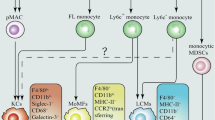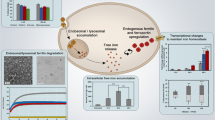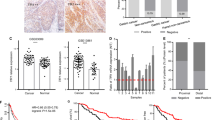Abstract
Until now, the Food and Drug Administration (FDA)-approved iron supplement ferumoxytol and other iron oxide nanoparticles have been used for treating iron deficiency, as contrast agents for magnetic resonance imaging and as drug carriers. Here, we show an intrinsic therapeutic effect of ferumoxytol on the growth of early mammary cancers, and lung cancer metastases in liver and lungs. In vitro, adenocarcinoma cells co-incubated with ferumoxytol and macrophages showed increased caspase-3 activity. Macrophages exposed to ferumoxytol displayed increased mRNA associated with pro-inflammatory Th1-type responses. In vivo, ferumoxytol significantly inhibited growth of subcutaneous adenocarcinomas in mice. In addition, intravenous ferumoxytol treatment before intravenous tumour cell challenge prevented development of liver metastasis. Fluorescence-activated cell sorting (FACS) and histopathology studies showed that the observed tumour growth inhibition was accompanied by increased presence of pro-inflammatory M1 macrophages in the tumour tissues. Our results suggest that ferumoxytol could be applied ‘off label’ to protect the liver from metastatic seeds and potentiate macrophage-modulating cancer immunotherapies.
This is a preview of subscription content, access via your institution
Access options
Subscribe to this journal
Receive 12 print issues and online access
$259.00 per year
only $21.58 per issue
Buy this article
- Purchase on Springer Link
- Instant access to full article PDF
Prices may be subject to local taxes which are calculated during checkout






Similar content being viewed by others
References
Corot, C., Robert, P., Idee, J. M. & Port, M. Recent advances in iron oxide nanocrystal technology for medical imaging. Adv. Drug Deliv. Rev. 58, 1471–1504 (2006).
Daldrup-Link, H. E. et al. MRI of tumor-associated macrophages with clinically applicable iron oxide nanoparticles. Clin. Cancer Res. 17, 5695–5704 (2011).
Klenk, C. et al. Ionising radiation-free whole-body MRI versus 18F-fluorodeoxyglucose PET/CT scans for children and young adults with cancer: a prospective, non-randomised, single-centre study. Lancet Oncol. 15, 275–285 (2014).
Ansari, C. et al. Development of novel tumor-targeted theranostic nanoparticles activated by membrane-type matrix metalloproteinases for combined cancer magnetic resonance imaging and therapy. Small 10, 566–575 (2014).
Neuwelt, E. A. et al. The potential of ferumoxytol nanoparticle magnetic resonance imaging, perfusion, and angiography in central nervous system malignancy: a pilot study. Neurosurgery 60, 601–611 (2007).
Daldrup-Link, H. & Coussens, L. M. MR imaging of tumor-associated macrophages. Oncoimmunology 1, 507–509 (2012).
Vinogradov, S., Warren, G. & Wei, X. Macrophages associated with tumors as potential targets and therapeutic intermediates. Nanomedicine 9, 695–707 (2014).
Miller, M. A. et al. Tumour-associated macrophages act as a slow-release reservoir of nano-therapeutic Pt(IV) pro-drug. Nat. Commun. 6, 8692 (2015).
Weissleder, R., Nahrendorf, M. & Pittet, M. J. Imaging macrophages with nanoparticles. Nat. Mater. 13, 125–138 (2014).
Li, C. A targeted approach to cancer imaging and therapy. Nat. Mater. 13, 110–115 (2014).
Futterer, S., Andrusenko, I., Kolb, U., Hofmeister, W. & Langguth, P. Structural characterization of iron oxide/hydroxide nanoparticles in nine different parenteral drugs for the treatment of iron deficiency anaemia by electron diffraction (ED) and X-ray powder diffraction (XRPD). J. Pharm. Biomed. Anal. 86, 151–160 (2013).
Ittrich, H., Peldschus, K., Raabe, N., Kaul, M. & Adam, G. Superparamagnetic iron oxide nanoparticles in biomedicine: applications and developments in diagnostics and therapy. RoFo 185, 1149–1166 (2013).
Richards, J. M. et al. In vivo mononuclear cell tracking using superparamagnetic particles of iron oxide: feasibility and safety in humans. Circ. Cardiovasc. Imaging 5, 509–517 (2012).
Warheit, D. B. & Hartsky, M. A. Role of alveolar macrophage chemotaxis and phagocytosis in pulmonary clearance responses to inhaled particles: comparisons among rodent species. Microsc. Res. Tech 26, 412–422 (1993).
Sindrilaru, A. et al. An unrestrained proinflammatory M1 macrophage population induced by iron impairs wound healing in humans and mice. J. Clin. Invest. 121, 985–997 (2011).
Wodarz, D. & Anton-Culver, H. Dynamical interactions between multiple cancers. Cell Cycle 4, 764–771 (2005).
Nejadnik, H. et al. Somatic differentiation and MR imaging of magnetically labeled human embryonic stem cells. Cell Transplant. 21, 2555–2567 (2012).
Jahchan, N. S. et al. A drug repositioning approach identifies tricyclic antidepressants as inhibitors of small cell lung cancer and other neuroendocrine tumors. Cancer Discov. 3, 1364–1377 (2013).
Lu, M., Cohen, M. H., Rieves, D. & Pazdur, R. FDA report: ferumoxytol for intravenous iron therapy in adult patients with chronic kidney disease. Am. J. Hematol. 85, 315–319 (2010).
Choi, J. Y. et al. Iron intake, oxidative stress-related genes (MnSOD and MPO) and prostate cancer risk in CARET cohort. Carcinogenesis 29, 964–970 (2008).
Poljak-Blazi, M. et al. Effect of ferric ions on reactive oxygen species formation, cervical cancer cell lines growth and E6/E7 oncogene expression. Toxicol. In Vitro 25, 160–166 (2011).
Crowe, W. E., Maglova, L. M., Ponka, P. & Russell, J. M. Human cytomegalovirus-induced host cell enlargement is iron dependent. Am. J. Physiol. Cell Physiol. 287, C1023–C1030 (2004).
Petersen, D. R. Alcohol, iron-associated oxidative stress, and cancer. Alcohol 35, 243–249 (2005).
Nie, G., Chen, G., Sheftel, A. D., Pantopoulos, K. & Ponka, P. In vivo tumor growth is inhibited by cytosolic iron deprivation caused by the expression of mitochondrial ferritin. Blood 108, 2428–2434 (2006).
Knobel, Y., Glei, M., Osswald, K. & Pool-Zobel, B. L. Ferric iron increases ROS formation, modulates cell growth and enhances genotoxic damage by 4-hydroxynonenal in human colon tumor cells. Toxicol. In Vitro 20, 793–800 (2006).
Basel, M. T. et al. Cell-delivered magnetic nanoparticles caused hyperthermia-mediated increased survival in a murine pancreatic cancer model. Int. J. Nanomedicine 7, 297–306 (2012).
Chung, T. H. et al. Iron oxide nanoparticle-induced epidermal growth factor receptor expression in human stem cells for tumor therapy. ACS Nano 5, 9807–9816 (2011).
Foy, S. P. & Labhasetwar, V. Oh the irony: iron as a cancer cause or cure? Biomaterials 32, 9155–9158 (2011).
Reinisch, W., Staun, M., Bhandari, S. & Munoz, M. State of the iron: how to diagnose and efficiently treat iron deficiency anemia in inflammatory bowel disease. J. Crohns Colitis 7, 429–440 (2013).
Lunov, O. et al. Lysosomal degradation of the carboxydextran shell of coated superparamagnetic iron oxide nanoparticles and the fate of professional phagocytes. Biomaterials 31, 9015–9022 (2010).
Gupta, A. K. & Wells, S. Surface-modified superparamagnetic nanoparticles for drug delivery: preparation, characterization, and cytotoxicity studies. IEEE Trans. Nanobioscience 3, 66–73 (2004).
Mou, W. et al. Expression of Sox2 in breast cancer cells promotes the recruitment of M2 macrophages to tumor microenvironment. Cancer Lett. 358, 115–123 (2015).
Becker, M., Muller, C. B., De Bastiani, M. A. & Klamt, F. The prognostic impact of tumor-associated macrophages and intra-tumoral apoptosis in non-small cell lung cancer. Histol. Histopathol. 29, 21–31 (2014).
Laskar, A., Eilertsen, J., Li, W. & Yuan, X. M. SPION primes THP1 derived M2 macrophages towards M1-like macrophages. Biochem. Biophys. Res. Commun. 441, 737–742 (2013).
Solinas, G., Germano, G., Mantovani, A. & Allavena, P. Tumor-associated macrophages (TAM) as major players of the cancer-related inflammation. J. Leukoc. Biol. 86, 1065–1073 (2009).
Franklin, R. A. et al. The cellular and molecular origin of tumor-associated macrophages. Science 344, 921–925 (2014).
Edris, B. et al. Antibody therapy targeting the CD47 protein is effective in a model of aggressive metastatic leiomyosarcoma. Proc. Natl Acad. Sci. USA 109, 6656–6661 (2012).
Shiao, S. L. et al. TH2-polarized CD4+ T cells and macrophages limit efficacy of radiotherapy. Cancer Immunol. Res. 3, 518–525 (2015).
Hadjipanayis, C. G. et al. EGFRvIII antibody-conjugated iron oxide nanoparticles for magnetic resonance imaging-guided convection-enhanced delivery and targeted therapy of glioblastoma. Cancer Res. 70, 6303–6312 (2010).
Thorek, D. L. et al. Non-invasive mapping of deep-tissue lymph nodes in live animals using a multimodal PET/MRI nanoparticle. Nat. Commun. 5, 3097 (2014).
Rosner, M. H. & Auerbach, M. Ferumoxytol for the treatment of iron deficiency. Expert Rev. Hematol. 4, 399–406 (2011).
Cheng, K. et al. Magnetic antibody-linked nanomatchmakers for therapeutic cell targeting. Nat. Commun. 5, 4880 (2014).
Acknowledgements
The authors acknowledge support from the National Institute of Health/National Cancer Institute (NIH/NCI), grant numbers R21CA156124 and R21CA176519, and the Department of Defense BCRP Era of Hope Scholar Expansion Award (BC10412). S.Z. was supported by the Stanford Cancer Imaging Training (SCIT) T32 fellowship programme. We also thank the Stanford Center for Innovation and In-Vivo Imaging (SCI 3) supported by the NCI Cancer Center (P30 CA124435–02) and NCI ICMIC (P50 CA114747) for providing the infrastructure for mouse imaging. G.H. was supported by a Swiss National Science Foundation Grant P-155336 (www.snf.ch) and the Novartis Foundation for Medical-Biological Research (www.stiftungmedbiol.novartis.com). In addition, we thank E. Misquez for her excellent administrative assistance throughout this project, D. Yang for assistance with cell culture and M. Winslow's laboratory (Stanford University) for their generous gift of the SCLC KP1-GFP-Luc cell lines.
Author information
Authors and Affiliations
Contributions
The study concept and design was developed by H.E.D.-L., L.M.C. and S.Z. The acquisition of data was performed by S.Z., R.S., G.H., M.Ma., S.G. and A.S. (cell experiments, tissue experiments and immunohistochemistry), S.Z., J.S.P., O.L. and H.N. (animal experiments), S.Z., O.L., M.Mo. (magnetic resonance imaging), and S.Z., G.H., A.S. (flow cytometry). All authors contributed to the analysis of the data and discussed the results. H.E.D.-L. and S.Z. wrote the manuscript. All authors edited the manuscript and approved the final version. Funding was obtained by H.E.D.-L. and all studies were supervised by H.E.D.-L.
Corresponding author
Ethics declarations
Competing interests
The authors declare no competing financial interests.
Supplementary information
Supplementary information
Supplementary information (PDF 1038 kb)
Rights and permissions
About this article
Cite this article
Zanganeh, S., Hutter, G., Spitler, R. et al. Iron oxide nanoparticles inhibit tumour growth by inducing pro-inflammatory macrophage polarization in tumour tissues. Nature Nanotech 11, 986–994 (2016). https://doi.org/10.1038/nnano.2016.168
Received:
Accepted:
Published:
Issue Date:
DOI: https://doi.org/10.1038/nnano.2016.168
This article is cited by
-
The application of nanoparticles-based ferroptosis, pyroptosis and autophagy in cancer immunotherapy
Journal of Nanobiotechnology (2024)
-
“All in one” nanoprobe Au-TTF-1 for target FL/CT bioimaging, machine learning technology and imaging-guided photothermal therapy against lung adenocarcinoma
Journal of Nanobiotechnology (2024)
-
Arsenic album 30C exhibits crystalline nano structure of arsenic trioxide and modulates innate immune markers in murine macrophage cell lines
Scientific Reports (2024)
-
Nanomedicine targeting ferroptosis to overcome anticancer therapeutic resistance
Science China Life Sciences (2024)
-
Fe-doped carbon dots: a novel biocompatible nanoplatform for multi-level cancer therapy
Journal of Nanobiotechnology (2023)



